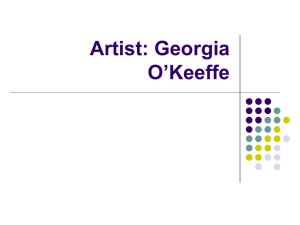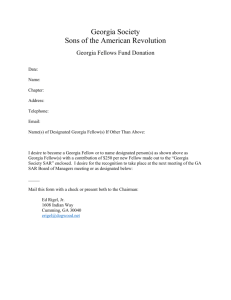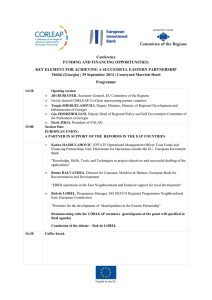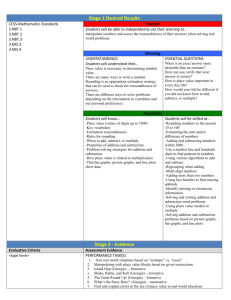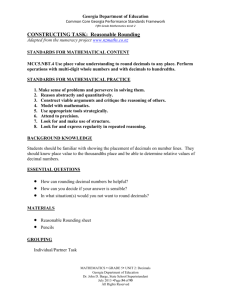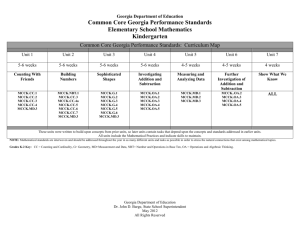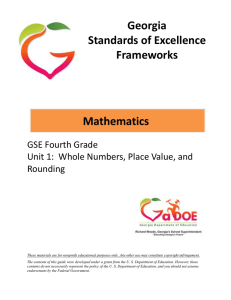3rd Grade Unit 1 Lesson Sequence
advertisement
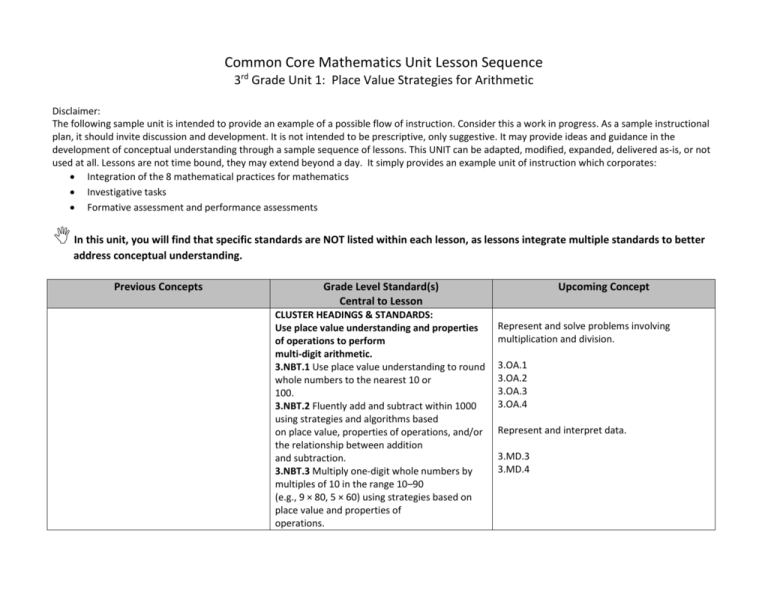
Common Core Mathematics Unit Lesson Sequence 3rd Grade Unit 1: Place Value Strategies for Arithmetic Disclaimer: The following sample unit is intended to provide an example of a possible flow of instruction. Consider this a work in progress. As a sample instructional plan, it should invite discussion and development. It is not intended to be prescriptive, only suggestive. It may provide ideas and guidance in the development of conceptual understanding through a sample sequence of lessons. This UNIT can be adapted, modified, expanded, delivered as-is, or not used at all. Lessons are not time bound, they may extend beyond a day. It simply provides an example unit of instruction which corporates: Integration of the 8 mathematical practices for mathematics Investigative tasks Formative assessment and performance assessments In this unit, you will find that specific standards are NOT listed within each lesson, as lessons integrate multiple standards to better address conceptual understanding. Previous Concepts Grade Level Standard(s) Central to Lesson CLUSTER HEADINGS & STANDARDS: Use place value understanding and properties of operations to perform multi‐digit arithmetic. 3.NBT.1 Use place value understanding to round whole numbers to the nearest 10 or 100. 3.NBT.2 Fluently add and subtract within 1000 using strategies and algorithms based on place value, properties of operations, and/or the relationship between addition and subtraction. 3.NBT.3 Multiply one‐digit whole numbers by multiples of 10 in the range 10–90 (e.g., 9 × 80, 5 × 60) using strategies based on place value and properties of operations. Upcoming Concept Represent and solve problems involving multiplication and division. 3.OA.1 3.OA.2 3.OA.3 3.OA.4 Represent and interpret data. 3.MD.3 3.MD.4 Previous Concepts Grade Level Standard(s) Central to Lesson Represent and interpret data. 3.MD.3 Draw a scaled picture graph and a scaled bar graph to represent a data set with several categories. Solve one‐ and two‐step “how many more” and “how many less” problems using information presented in scaled bar graphs. For example, draw a bar graph in which each square in the bar graph might represent 5 pets. 3.MD.4 Generate measurement data by measuring lengths using rulers marked with halves and fourths of an inch. Show the data by making a line plot, where the horizontal scale is marked off in appropriate units – whole numbers, halves, or Upcoming Concept Lesson Number 1 2 3 4 5 6 7 8 9 10 11 12 Title of Lesson & Description Three Other Ways – This provides an opportunity to decompose numbers in multiple ways. This will help them easily manipulate numbers as needed in computation, as well as understand the value of digits in numbers when rounding. Round to the Nearest Ten – Students practice estimation and rounding skills through engaging in a card game. Round to the Nearest Hundred - Students practice estimation and rounding skills through engaging in a card game. Round Up or Down? – Students must decide where numbers belong on a number line. 3 Digit Addition Split – Students solve 3 digit addition problems by decomposing the addends into hundreds, tens and ones before adding. Happy to Eat Healthy – Students use a menu to decide which items to purchase given a specific amount of money to spend. Field Day Fun – Student solve addition and subtraction problems. I Have a Story, You Have a Story – Students write their own story problem. “The Information Station” – Students create different graphs after collecting data. It’s a Data Party - Lesson and/or Performance Task What’s Your Favorite? – Students survey their classmates to collect data and then display data using pictographs and Venn diagrams. Cut and Plot! – Students measure varying string lengths and create a line plot. Materials & Resources Georgia Department of Education: Unit 1: Numbers and Operations in Base Ten (p. 15-20) K-5MathTeachingResources.com Playing Cards (0-9) K-5MathTeachingResources.com Playing Cards (0-9) K-5MathTeachingResources.com K-MathTeachingResources.com Georgia Department of Education: Unit 1: Numbers and Operations in Base Ten (p. 70-77) Georgia Department of Education: Unit 1: Numbers and Operations in Base Ten (p. 78-81) Georgia Department of Education: Unit 1: Numbers and Operations in Base Ten (p. 82 - 87) Georgia Department of Education: Unit 1: Numbers and Operations in Base Ten (p. 88-91) Georgia Department of Education: Unit 1: Numbers and Operations in Base Ten (p. 92-95) Georgia Department of Education: Unit 1: Numbers and Operations in Base Ten (p. 96-102) Georgia Department of Education: Unit 1: Numbers and Operations in Base Ten (p. 103-106)

